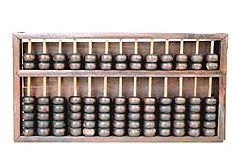Everything About the Chinese Abacus With Online Soroban

This article gives students a cultural tour of all mathematical tools related to the soroban and chinese abacus online.
They are able to learn about the meaning of the beads and positioning of each beads interpreted by people in different countries and culture.
I'm the author of this article and I'm a qualified abacus teacher, answering questions from around the world online abacus and various questions from online-soroban.com students.
Table of contents

Of all the devices and tools used in ancient times, the abacus is undoubtedly one of the few that has survived to our days, a tool that has facilitated the approach to mathematics for centuries.
But how did the soroban come to exist? And why it is still relevant today?
A soroban is known as a calculating tool used to perform basic math operations, invented centuries back in Asia to help merchants keep track of their sales.
With it, people can solve additions, subtractions, multiplications, and divisions; as well as counting decimal places, calculating with negative numbers, and extract square and cubic roots.
This small tool is typically made of different types of wood, although cheaper abacuses are made of plastic, and come in varying sizes.
1-1.What Is the Chinese Abacus and Can You Do It Online?

Before the invention of proper counting machines, people used their fingers, rocks or made marks in the sand to keep track of quantities.
The first tabulating device known were simple shallow trays filled with a layer of sand, in which number symbols were marked and erased easily with a finger.
It is unknown who and when was build the first modern soroban– in terms of rows and beads in their structure – but there's evidence that goes back as early as 2700 B.C.in ancient Babylon, being used with a sexagesimal numbering system.
While it may precede the current calculators, the soroban is not comparable to it, mainly because it is a mechanical aid used for counting, providing students an enhanced visual guide to solving math problems, similar to counting with fingers or using paper and pencil.
It was invented even before the existence of Arabic numbers.
While is better to learn the sorobans' principles with a master of it, there are online sources that provide guides to any person that wants to learn how to use the soroban(either with a physical tabulating device or an online one).
It can help users get used to knowing how to represent numbers on the calculating device, and to learn how to solve basic math operations.
It's important, though, for the person to know what type of mental calculation they want to learn since there are different guides either to learn the Japanese Soroban or to the Chinese Suanpan.
1-2.Using Technology to Learn Chinese Abacus and Soroban Online

Although most of the world uses modern calculators and computers for mathematical operations, some countries like Japan, China, and even Russia keep using the abacus not only as a teaching tool but in their day to day operations as well.
Each one of these countries has different types of abacuses, with different numbering systems and different designs in their structure.
While some declined in use, some are still taught across different schools in the world, such as the Soroban and the Suanpan, previously mentioned above.
The Soroban, or Japanese abacus, is the most used type in actuality since it has a decimal numbering system, allowing the user to work with numbers from 0 through 9.
It is inspired directly by the Chinese Suanpan and is composed of an odd number of rods (the standard is 13, but there's Sorobans composed by 21 or even 31 rods), divided by the reckoning bar.
It is also the predominant abacus used to teach basic math to little kid.
The upper beads are called “heavenly beads”, having a worth of five in the first rod; while the four lower beads are called “earthly beads”, each one having a single value of one in the first rod.
In order to make a calculus in the Soroban, the user needs to move the beads towards the reckoning bar, to put them in an “on” position to assume value; when a bead is near the middle bar, it’s considered counted, and when no bead is touching it the column is equal to zero.
Unlike the Soroban, the Chinese Suanpan uses a base 16 as its numbering system, having two beads on each rod in the upper deck, and five beads in the bottom deck.
It is referred to as the classical or traditional abacus.
The value of the bead is the same as in the Soroban, with the difference that the user can choose to represent the 10, for example, either by moving down the two beads of the first rod or moving up the first bead of the second rod, when with the Soroban it can be only be represented in the second form.
Another important difference between the Japanese and Chinese abacus is that the Japanese have a marking dot every three rows, used to represent decimal numbers (when the number is placed to the right of the dot) and to represent the place value (when the number is to its left instead).
This allows the user to solve math problems with different decimals on it.
As such, students are able to use their brains more efficiently and learn with classes personalized to their learning pace with schedule flexibility.
1-3. Other Types of (Chinese) Abacus From All Over the World Online

Along the previously mentioned abacuses, there are other types of it such as the Vietnamese abacus (with five beads in both upper and lower sides, representing power to ten per column); and the Russian abacus or Schoty, in which the rods are in a horizontal position and the beads have to be moved towards the left to manipulate the numbers, not having a separation bar between each row.
It came into use around 1600, specifically designed for counting rubles and kopeks (Russia's currency).
Each column of beads represents a place value, being the farthest column on the right the "ones" place, the second farther the "tens" place, the third farthest the "hundreds", and so on. This applies to each abacus, regardless of its type.
Overall
Despite being centuries old, the soroban continues to be used throughout the world to facilitate the teaching of mathematics to children (and adults), as its practical use has been proven by facilitating the visualization of numbers and different arithmetic operations, being undoubtedly a tool that manages to last over time.
| Tweet |










